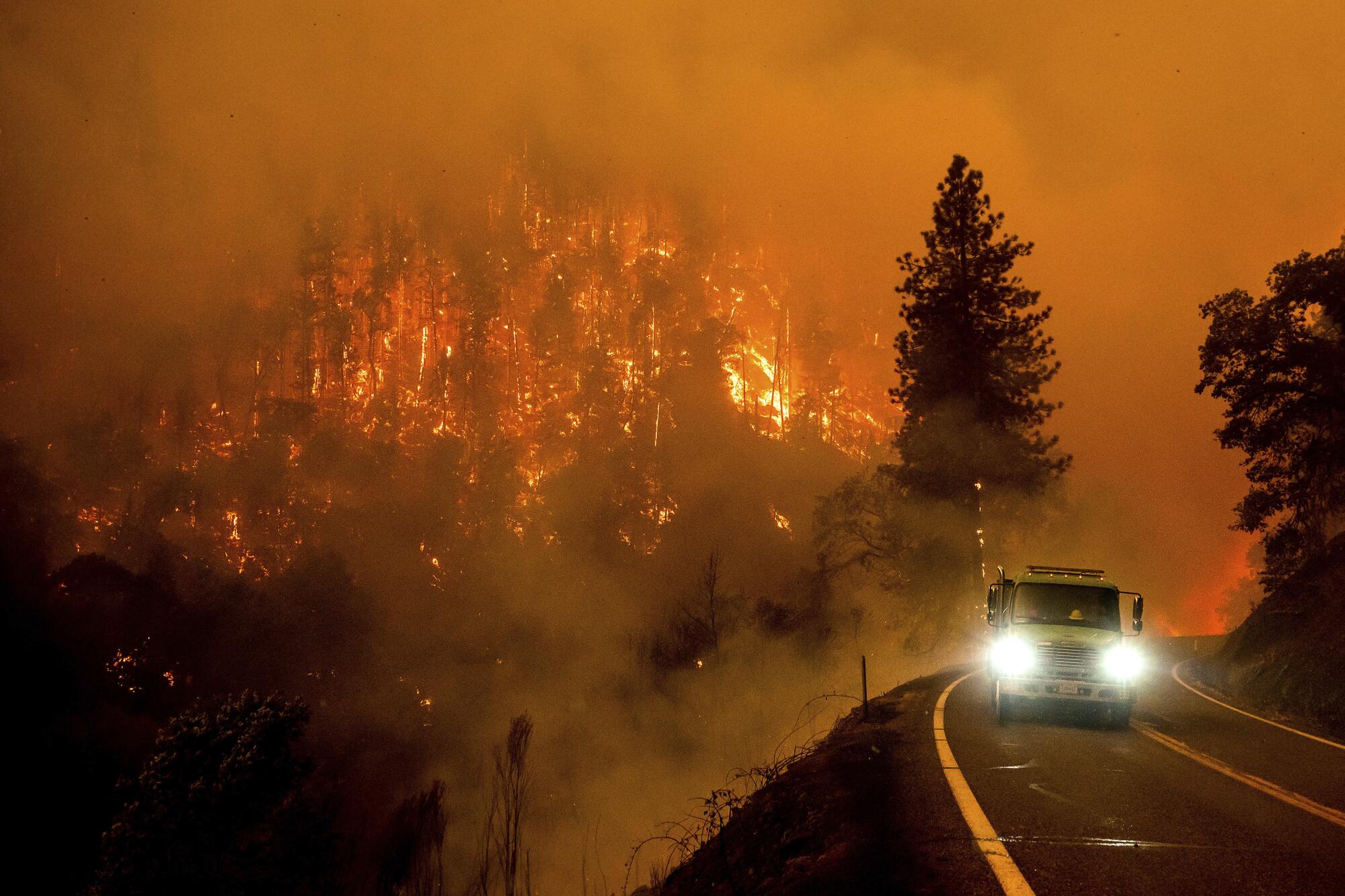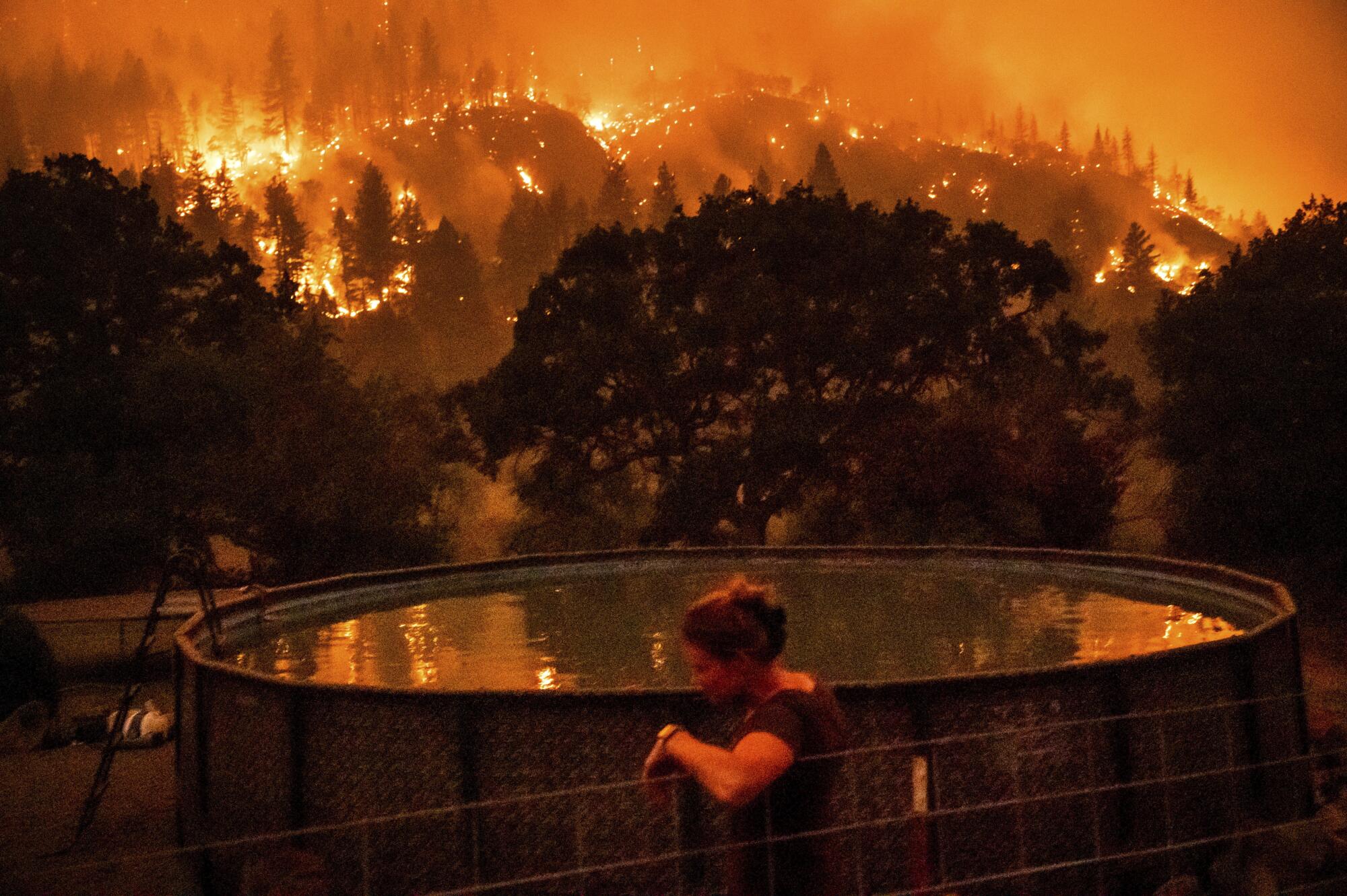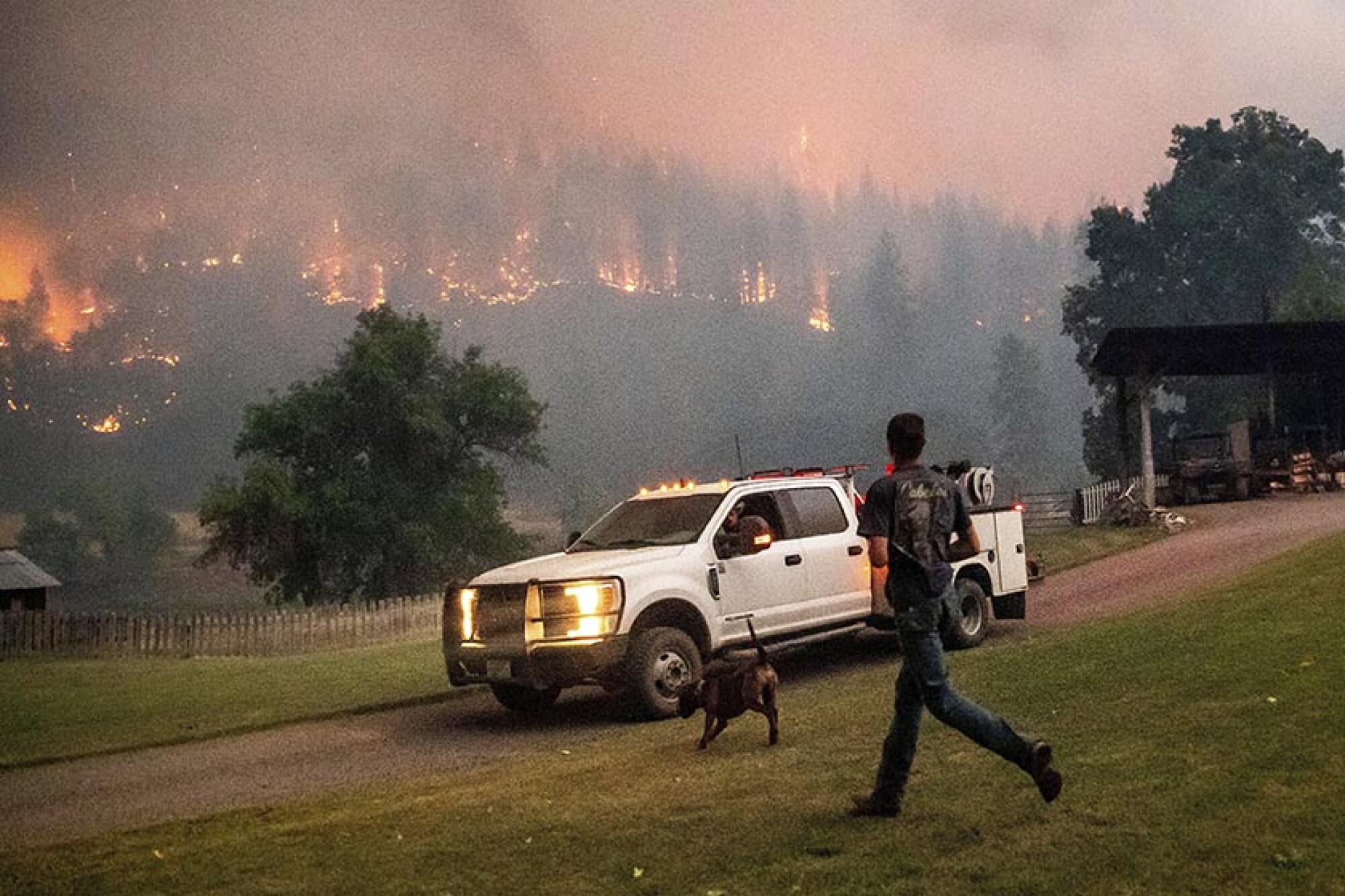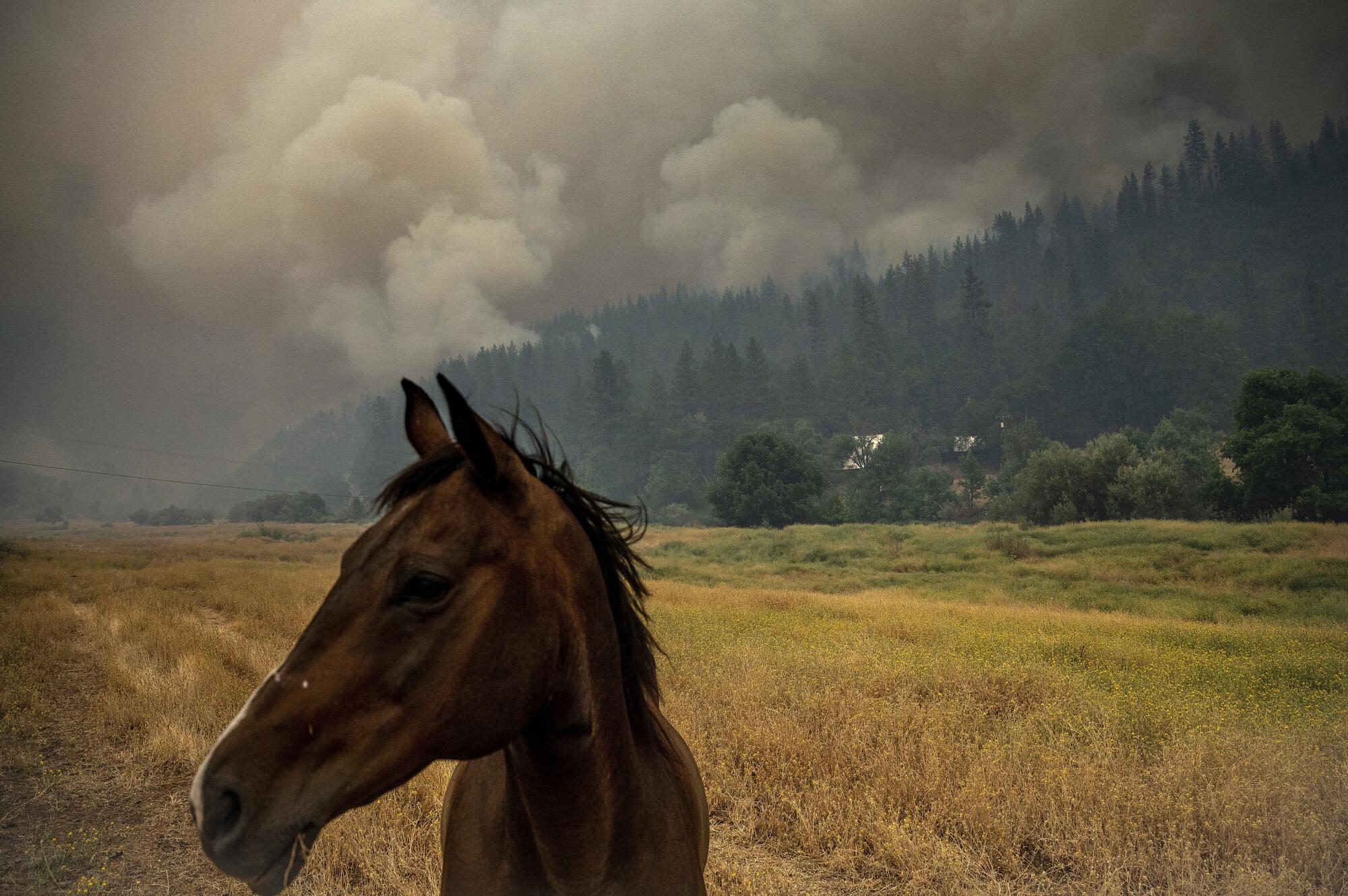
- Share via
A fast-moving wildfire near the California border with Oregon continued to rage out of control Sunday, burning tens of thousands of acres and prompting evacuation orders for neighboring communities.
The McKinney fire is burning through heavy, drought-stressed timber in steep terrain in the Klamath National Forest west of Yreka, said Caroline Quintanilla, a public information officer.
It’s shaping up to be the most dangerous fire so far this season in California, threatening multiple communities. The U.S. Forest Service estimated the fire had grown to 51,468 acres as of Sunday morning with 0% containment.
Evacuation orders were issued for multiple communities, including Scott Bar, Klamath River and Horse Creek. The orders encompassed at least 500 homes, according to the Siskiyou County Sheriff’s Office.

Western pockets of Yreka, the county seat, were ordered to evacuate Saturday night. All other areas of the city west of Interstate 5 were warned to prepare for the possibility of evacuation.
The dynamic situation forced firefighters to shift their efforts from controlling the perimeter of the fire to assisting with evacuations and defending structures, Quintanilla said.
A number of homes along the Shasta River have been destroyed, said Bryan Schenone, director of the county’s office of emergency management. Officials haven’t yet gotten an accurate count of the losses because of fire danger.
Gov. Gavin Newsom proclaimed a state of emergency for Siskiyou County on Saturday due to the effects of the McKinney fire. Two additional fires in the county, the China 2 and Evans fires, merged and were thought to have burned more than 300 acres in the afternoon. That was revised to 100 to 150 acres by evening.
Lisa Mott, 45, of Montague said she has friends whose parents have lost houses down in the Klamath River area. Mott, who works in Yreka and has family there, said the city has warned residents to be ready “in case the fire crests over the hill and comes toward the town.”
Ash fell on her car as she drove to the county seat Saturday afternoon, she said.

“We’re all preparing in case we have to evacuate the town,” she said. “People in town are starting to pack up, getting stuff ready.”
Mott spoke from her father’s house in Grenada, where she went to get their pickup and horse trailer ready in case they have to help friends and family evacuate.
The McKinney fire has ripped through 52,498 acres in Klamath National Forest. A red flag warning is in effect, and storms are expected.
Her family had planned to head to Redding for a scholarship dinner for her daughter that night, but decided to stay in case friends and family need their help.
“We’re just kind of all sitting, waiting to see what happens,” she said. “We’re all waiting to see what this fire does.”
Many residents are worried about the weather conditions, Mott said.
“The weather conditions here aren’t very favorable, and I think this afternoon that’s what we’re all worried about, the weather that’s supposed to be coming through,” she said.

Jon Fitzpatrick a 19-year resident of Yreka, lives on the edge of the evacuation warning zone with his wife and three sons. As of Saturday afternoon, the fire was reported to be nine miles west of them, just over a ridge. They could see a growing smoke cloud.
“We have fires every year in the surrounding areas,” he said. “But here in Yreka this is the first time I have felt like it could possibly threaten the town.”
He and his family packed clothes and toiletries and had important papers and pictures in baskets, ready to go.
“We will wait and see if it gets closer and as soon as they say to go, we will put the rest of the things in the car, load up the dogs, and head out,” he said.
A pastor in the community, Fitzpatrick said he was “more concerned for our older people who will have a bigger challenge getting out of town if need be.”
He said that there was a dusting of ash, but it wasn’t too bad given the direction of the wind. But he knew conditions could change.
“This thing is a beast,” he said.
The fire started Friday afternoon on the south side of the Klamath River amid record-breaking heat and grew to 800 acres by Friday night.

A weather station in Montague, down in the Shasta Valley to the east of the fire, had recorded six days of triple-digit temperatures that peaked Friday at 111 degrees, with the heat breaking daily records each day Monday through Friday, according to preliminary National Weather Service data. On Wednesday, Thursday and Friday, the heat surpassed the highest temperature ever recorded by the station: 109 degrees on June 27, 2021.
Flames were fanned by erratic winds from thunderstorms that moved through the area overnight, Quintanilla said.
“The whole fire triangle is in effect — heat, fuels and wind,” she said.
Intense heat from the fire sent up a massive pyrocumulonimbus cloud that reached at least 39,000 feet into the sky, said Misty Firmin, meteorologist with the National Weather Service in Medford, Ore. These fire storm clouds can potentially produce lightning and strong, gusty winds, she said. When the cloud collapsed Friday night, an outflow of air kicked off an additional thunderstorm, she said.
Research has shown that long-term warming has contributed to about half of the area burned in the Western United States over the last four decades, primarily by drying vegetation, said climate scientist Noah Diffenbaugh, a professor and senior fellow at Stanford University.
“We also know that in the shorter term, heat waves can really amplify those longer-term conditions and create very dry fuel conditions,” he said. “We’ve certainly seen that in recent large wildfires in California.”
Diffenbaugh’s research has found that a disproportionate fraction of the area burned by fire coincides with the most severe fire weather conditions, which take place when a moisture deficit, hot temperatures, low humidity and wind combine.
“Those days that have the most severe wildfire weather conditions are most responsible for larger fires,” he said.

Climate change is boosting the chances these conditions will align by increasing both mean temperatures and the frequency of severe heat waves, he said. Warming has also increased the risk of severe drought by causing more precipitation to fall as rain rather than snow and increasing the amount of moisture the atmosphere draws from plants and soils, he said.
While important, temperature is not the only influence on fire activity, he said. Land management decisions, vegetation type and condition and resources available to respond to a fire are also key. But if the planet continues to warm, more severe heat and an even greater frequency of extreme wildfire weather can be expected, he said.
The cause of the McKinney fire remained under investigation.
The National Weather Service issued a red-flag warning for the area through Saturday, saying that scattered thunderstorms could result in abundant lightning striking critically dry vegetation. A fire weather watch is also in effect through Sunday.
More to Read
Sign up for Essential California
The most important California stories and recommendations in your inbox every morning.
You may occasionally receive promotional content from the Los Angeles Times.

















